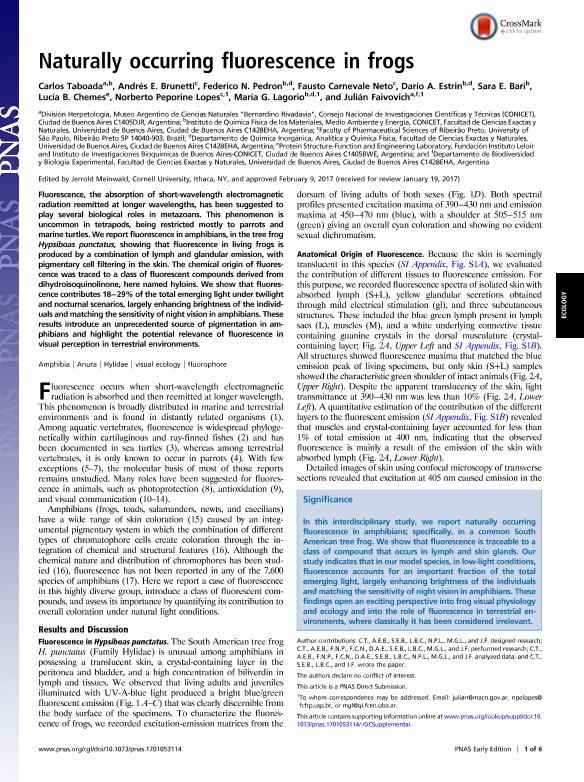Artículo
Naturally occurring fluorescence in frogs
Taboada, Carlos Alberto ; Brunetti, Andrés Eduardo
; Brunetti, Andrés Eduardo ; Pedron, Federico N.; Neto, Fausto Carnevale; Estrin, Dario Ariel
; Pedron, Federico N.; Neto, Fausto Carnevale; Estrin, Dario Ariel ; Bari, Sara Elizabeth
; Bari, Sara Elizabeth ; Chemes, Lucia Beatriz
; Chemes, Lucia Beatriz ; Peporine Lopes, Norberto; Lagorio, María Gabriela
; Peporine Lopes, Norberto; Lagorio, María Gabriela ; Faivovich, Julián
; Faivovich, Julián
 ; Brunetti, Andrés Eduardo
; Brunetti, Andrés Eduardo ; Pedron, Federico N.; Neto, Fausto Carnevale; Estrin, Dario Ariel
; Pedron, Federico N.; Neto, Fausto Carnevale; Estrin, Dario Ariel ; Bari, Sara Elizabeth
; Bari, Sara Elizabeth ; Chemes, Lucia Beatriz
; Chemes, Lucia Beatriz ; Peporine Lopes, Norberto; Lagorio, María Gabriela
; Peporine Lopes, Norberto; Lagorio, María Gabriela ; Faivovich, Julián
; Faivovich, Julián
Fecha de publicación:
04/2017
Editorial:
National Academy of Sciences
Revista:
Proceedings of the National Academy of Sciences of The United States of America
ISSN:
0027-8424
Idioma:
Inglés
Tipo de recurso:
Artículo publicado
Clasificación temática:
Resumen
Fluorescence, the absorption of short-wavelength electromagnetic radiation reemitted at longer wavelengths, has been suggested to play several biological roles in metazoans. This phenomenon is uncommon in tetrapods, being restricted mostly to parrots and marine turtles. We report fluorescence in amphibians, in the tree frog Hypsiboas punctatus, showing that fluorescence in living frogs is produced by a combination of lymph and glandular emission, with pigmentary cell filtering in the skin. The chemical origin of fluorescence was traced to a class of fluorescent compounds derived from dihydroisoquinolinone, here named hyloins. We show that fluorescence contributes 18−29% of the total emerging light under twilight and nocturnal scenarios, largely enhancing brightness of the individuals and matching the sensitivity of night vision in amphibians. These results introduce an unprecedented source of pigmentation in amphibians and highlight the potential relevance of fluorescence in visual perception in terrestrial environments.
Palabras clave:
Amphibia
,
Anura
,
Fluorophore
,
Hylidae
,
Visual Ecology
Archivos asociados
Licencia
Identificadores
Colecciones
Articulos(IIBBA)
Articulos de INST.DE INVEST.BIOQUIMICAS DE BS.AS(I)
Articulos de INST.DE INVEST.BIOQUIMICAS DE BS.AS(I)
Articulos(INQUIMAE)
Articulos de INST.D/QUIM FIS D/L MATERIALES MEDIOAMB Y ENERGIA
Articulos de INST.D/QUIM FIS D/L MATERIALES MEDIOAMB Y ENERGIA
Articulos(MACNBR)
Articulos de MUSEO ARG.DE CS.NAT "BERNARDINO RIVADAVIA"
Articulos de MUSEO ARG.DE CS.NAT "BERNARDINO RIVADAVIA"
Citación
Faivovich, Julián; Brunetti, Andrés Eduardo; Bari, Sara Elizabeth; Estrin, Dario Ariel; Taboada, Carlos Alberto; Pedron, Federico N.; et al.; Naturally occurring fluorescence in frogs; National Academy of Sciences; Proceedings of the National Academy of Sciences of The United States of America; 114; 14; 4-2017; 3672-3677
Compartir
Altmétricas



